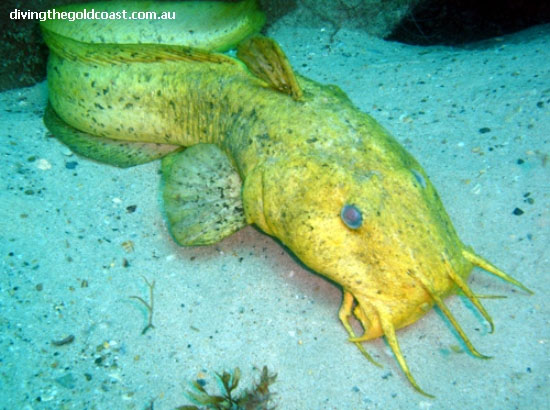| Plotosidae (Eeltail catfishes) |
| 91 cm SL (male/unsexed); max.weight: 2,500.0 g; max. reported age: 13 years |
|
demersal; brackish; marine; depth range 1 - 30 m |
| Indo-Pacific: endemic to Australia. Present along both eastern and western Australian coasts, from Kirra in southern Queensland to Jervis Bay in New South Wales, and from Kingston in South Australia to the Houtman Abrolhos in Western Australia. Distributional range extension to the Duck River in Tasmania (Ref. 7300) needs verification. |
|
Dorsal spines (total): 1-1; Dorsal soft rays (total): 105-134; Anal spines: 0-0; Anal soft rays: 95-112; Vertebrae: 77-78 |
| An inshore marine species which lives in shallow bays and sandy inlets near river mouths (Ref. 2156). Found most frequently over sand, rocks and weeds in clear to turbid waters. By day, cobblers are most often found in holes and on ledges in banks (Ref. 6390). They are opportunistic feeders, primarily feeding at night. Food consists of bivalve and univalve mollusks, crustaceans (small prawns and amphipods), polychaete worms, algae and organic debris (Ref. 26551). Juveniles eat more crustaceans, often from among drifting macrophytic algae (Ref. 26548). Adults feed mainly on mollusks and polychaetes (Ref. 6390). They are prey to birds such as cormorants and pelicans (Ref. 26548). Presence of sharp spines on the dorsal and pectoral fins can inflict painful wounds (Ref. 2156). |
|
Data deficient (DD); Date assessed: 04 February 2009 Ref. (130435)
|
| venomous |
|
Known from Kirra, Qld. To Jervis Bay, N.S.W. and Kingston, S.A. to Houtman Abrolhos Ils, W.A. (Ref. 6390) and Duck River, Tasmania (Ref. 7300). Distributional range extension to Tasmania needs verification.
Although it has been suggested that marine and estuarine populations of cobbler form independent populations, this has not been substantiated. The nature of the stock structure is unknown.
Commercial fishery: Cobbler have been exploited since the inception of the inshore, estuarine fishery in Western Australia, but targeted only in the last 25 years.
The commercial cobbler fishery is concentrated in southern waters between Perth and Albany. The Swan-Avon and Peel-Harvey estuaries are the traditional centers of the fishery. However, Wilson Inlet, emerged through recent years, as the major contributor to the overall catch.
The fishery is mainly located in the lower and middle sections of estuaries (Ref. 26559), with a few fish caught in marine embayments around Albany. Fishing goes on all year, although the catch per unit effort varies markedly with the season. The annual catch and catch per unit effort also fluctuate widely between years (Ref. 26547, 26558, 26559 ). Generally, cobbler together with sea mullet (Mugil cephalus) and yellow-eye mullet (Aldrichetta forsteri) comprise between 70% and 90% of the annual commercial catch from the southwest estuaries.
Cobbler are caught at night with bottom set gillnets and haul nets, bunting and funnel traps. The catch is consumed locally, mostly in Perth. Cobbler are marketed headed, gutted and on ice. In South Australian waters, small numbers of cobbler are taken as a bycatch of the haul net fishery, mainly in southern Spencer Gulf.
Recreational fishery: In Western Australia, cobbler are popular with recreational fishers. Along the south coast, most cobbler are caught with gillnets. On the west coast handlining is popular, especially in the Swan-Avon and Peel-Harvey estuaries and from the ocean around Hillary's Beach in Perth. Cobbler are also caught with hand spears at night. In southern Spencer Gulf (South Australia), cobbler are taken occasionally by recreational fishers. They are generally considered a nuisance, as they are difficult to remove from nets.
Resource status: The resource status is largely unknown. As of 1993, cobbler catches from the southwestern estuaries have declined and recreational fishing pressure has increased in inshore coastal waters. |
Source and more info: www.fishbase.org. For personal, classroom, and other internal use only. Not for publication.

